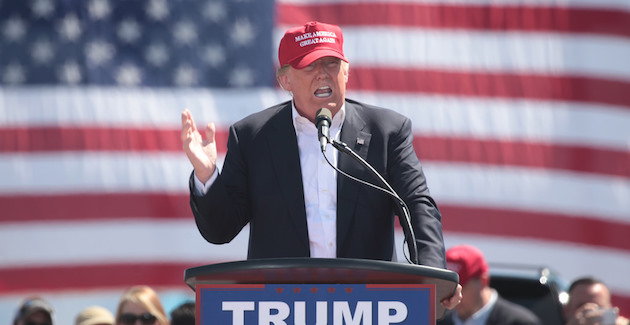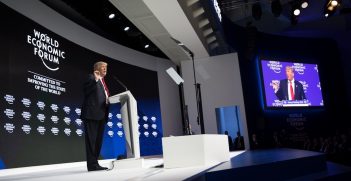Three Big Problems with Trump’s New NAFTA Plan

Renegotiation of the North American Free Trade Agreement was a cornerstone of Donald Trump’s aggressively populist presidential campaign. But as the details of Trump’s NAFTA plans emerge, it is becoming increasingly clear that they are deeply flawed.
The Trump administration has outlined its plans to renegotiate the North American Free Trade Agreement (NAFTA). It says the US will seek a “much better” agreement that reduces the trade deficit between the US and its partners, Canada and Mexico. In response, the two countries released brief statements welcoming the proposal. They say they consider a possible renegotiation as a step towards modernising NAFTA to address the new realities and challenges of the 21st century.
Despite these good intentions and purported goodwill, the US objectives for a revised NAFTA are unachievable. Three problems with the US negotiating position reveal the limited understanding of Donald Trump, the US trade representative, Robert Lighthizer (who will lead the negotiations), and their advisers about NAFTA and its side agreements.
- A mistaken view of job losses
The US case for renegotiating the agreement is based on the claim that NAFTA is to blame for various (and unspecified) “problems for many American workers”. Allegedly, these problems have led to the explosion of US trade deficits since 1994, when the agreement entered into force, and the closure of “thousands of factories”. According to the US trade office, this situation left millions of American workers “stranded” and unable to use the skills in which they had been trained.
As candidate and president, Trump has repeatedly claimed that “disastrous trade deals”, including NAFTA, resulted in the loss of manufacturing jobs in the US. But US manufacturing jobs were not lost to Mexico, they were lost to China and technological change.
Following its entry into the World Trade Organization in 2001, China became the world’s biggest exporter. Between 1999 and 2011, the US lost between 2 million and 2.4 million jobs to China, because of increasing American demand for cheaper Chinese products. Meanwhile, technological change meant that between 2000 and 2010, the US lost 4.8 million manufacturing jobs to machines, not foreign workers. Automation led to significant increases in US industrial output and made the US manufacturing sector more productive, at the expense of blue-collar jobs.
- The false trade argument
The US wants to redraft NAFTA into an agreement that provides it with a “more open, equitable, secure, and reciprocal access” to the Canadian and Mexican markets. At the same time, it expects to secure an agreement that allows Washington to establish protectionist “job-creating” policies at home. Such a double-edged agreement is unworkable and incongruous.
The US argument that its market of 321 million consumers is twice as large as Canada and Mexico’s combined (36 million and 119 million, correspondingly) also does not stack up. This is because NAFTA is mainly made up of intra-industry trade, where countries import and export similar goods from and to one another.
For instance, in 2002, the two largest US exports to Mexico were electrical machinery and appliances, and motor vehicles. These products were also the most important exports from Mexico to the US. NAFTA promotes this two-way exchange of goods because it liberalised trade between the three countries in a wide and nearly equal range of industrial classifications. In other words, it opened the US market to Mexico and Canada as much as it opened the Mexican and Canadian markets to the US.
The US has a [USD]60 billion dollar trade deficit with Mexico. It has been a one-sided deal from the beginning of NAFTA with massive numbers…
— Donald J. Trump (@realDonaldTrump) 26 January, 2017
The allegedly alarming figure of a US$64 billion US trade deficit with Mexico is concentrated in three industries: automobile, telecommunications and aeronautics. But because of its intra-industrial nature, the continued expansion in trade that NAFTA sustains does not cause a significant movement of manufacturing in any of these sectors or countries. And because the North American countries mostly trade the same products between them, setting tariffs in any sector will likely hurt workers in the same industries at home.
- Lip service on the environment
Trump’s trade office says it wants to strengthen environmental obligations, which are currently covered in NAFTA’s side agreements, and bring them into the main agreement. Yet the environmental protections proposed are already well-established in NAFTA’s framework and are governed by the US, Mexico and Canada through the Commission for Environmental Cooperation (CEC).
Specially, Trump’s trade representative has proposed establishing “a means for stakeholder participation”. It is hard to see how this would be different to the CEC’s existing Joint Public Advisory Committee, which promotes sustainable economic development in the region.
Like the rest of the CEC, this committee is at risk of losing its US share of funding and hence seeing its capacities severely reduced. Over the past 20 years, the CEC, the only trilateral, permanent environmental institution in North America, has received only about US$7m annually to carry out its work throughout the region.
As with many other programs and initiatives, the Trump administration is paying lip service to the wellbeing of the US environment, while cutting or committing limited funding for it. It is likely that the current administration will attempt to quietly quit the CEC. The Obama administration made a similar move, when it “temporarily” closed the managing institution for NAFTA’s side agreement on labour to review and enhance its operation. It never reopened it.
As with many other Trump campaign promises and government policies, the means, aims, and consequences of the intended renegotiation of NAFTA do not appear to have been carefully considered, let alone planned. Instead, its plans indicate that both the president and his lead negotiator have a very limited understanding of how NAFTA and its side agreements work.
And that is a not a solid basis for the US or its partners to start any negotiations.
Iván Farías Pelcastre is a vacation visiting research fellow at the Rothermere American Institute, University of Oxford.
Scott Lucas is professor of international politics at the University of Birmingham.
This article originally appeared on The Conversation on 25 July 2017. It is republished with permission.





